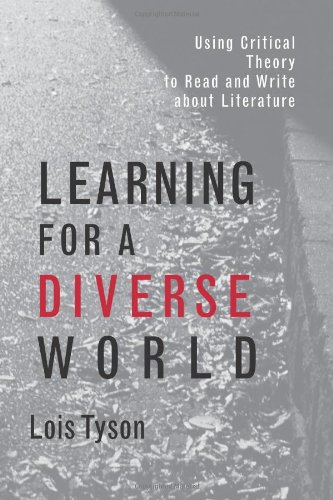معلومات عنا
حقوق الطبع والنشر © 2024 Desertcart Holdings Limited
Desert Online General Trading LLC
Dubai, United Arab Emirates


Full description not available
G**E
Tyson's amazing introduction to critical theory!
Having read and used Tyson's phenomenal book, Critical Theory Today: A User-Friendly Guide (Garland 1999), I couldn't wait to have my composition and literature community college students (and English majors) read Tyson's latest introduction to critical theory for beginners, Learning for a Diverse World: Using Critical Theory to Read and Write About Literature. The perfect classroom text or companion text for an Introduction to Composition and literature, Introduction to literature, Freshman Composition, American and/or British or Continental Literature as well as Humanities, Advanced Writing, and History or Philosophy courses, Learning for a Diverse World (Routledge 2001) works wonders in the classroom pedagogically-from offering in class activities that facilitate discussion and writing to providing a critical context for raising diversity issues in literature. Just as Tyson's Critical Theory Today: A User-Friendly Guide is an invaluable reference book for teachers wanting to introduce their students to critical theory, increase their repertoire of literary "readings," and to implement diversity issues in the college classroom, Tyson's Learning for a Diverse World is the ideal classroom text specifically geared for students. This much needed text has helped my students to understand and apply different critical approaches to literature as well as to become engaged in meaningful classroom activities and writing assignments involving analysis and close reading comprehension. I have witnessed first hand my students marvel at the ease with which they can understand the different theories. Truly classroom user-friendly, Learning for a Diverse World is a rhetorical masterpiece, making difficult philosophical concepts exciting and accessible for both teachers and students. I have used the first three chapters in my freshmen composition and literature course, Introduction to Women's Studies course, and American Writers II course. Specifically, in the American writers course, students appreciated Tyson's close reading exercises of each chapter. In fact one student commented, This [book] makes the literature make sense; I've never had a course that really showed me how to read and interpret literature. Usually the instructors assume we [students] already know how to write a good paper about literature." Another student described the sample literary readings of the different theories as "training wheels." Indeed, Tyson's succinct overview of the primary concepts of each theory along with extremely helpful exercises and questions about each theory that encourage students to relate the issues to their personal experiences puts students at ease while they discuss and write about complex subjects. When so many college teachers are talking about the importance of students being "critically aware" and developing critical thinking skills, Tyson's book arrives as a godsend. While some of my colleagues might think that "this critical theory stuff" goes over the heads of community college students, frequently I encounter students who are curious and want to know more about "those critical essays" that already appear in their "introduction to literature" anthologies. In fact, most of the "introduction to literature" anthologies that I've reviewed contain cursory, vague, and overly complicated excerpts from a wide range of "established" academic critics. Tyson's book helps students make sense and apply a diverse range of critical approaches with language that is accessible to those new to theory. Tyson's phenomenal book challenges students to think creatively and independently as they sharpen their critical reading and writing skills.
ترست بايلوت
منذ يومين
منذ شهر
منذ أسبوعين
منذ أسبوع